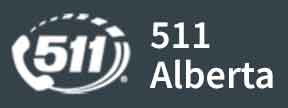Winter Operations FAQ | Mainroad Fraser Maintenance LP
During winter operations, Mainroad experiences a high frequency of questions from the public – this resource aims to answer most frequently asked questions and provide other helpful resources.
What is the road/highway service area that Mainroad Fraser Maintenance is responsible for maintaining?
Mainroad is responsible for the winter maintenance on the South Fraser Perimeter Road (SFPR). The SFPR is a four-lane, 80 km/hr route along the south side of the Fraser River, extending from 28th Avenue in Southwest Delta to 176th Street in Surrey. The Service Area is 166 lane kilometers and includes more than 100 structures (e.g. bridges, retaining walls, culverts, and sign structures).
*Please Note:
Mainroad is not responsible for plowing snow within municipal boundaries. Any snowplow discharge that falls on residential driveways is the responsibility of the property owner
TranBC Link: 4 Reasons Why Piling Your “Private Snow” on Roads is a “No”
Where are Mainroad's maintenance yards located?
Mainroad Fraser Maintenance’s headquarters and primary works yard is in Langley (Port Kells).
How many Mainroad employees are working during winter operations?
Up to 12 employees plus mechanical support are fully engaged in winter maintenance operations and available to work around the clock to keep our roads clear and safe.
How does Mainroad monitor weather and highways conditions?
Winter weather in the Lower Mainland can be quite unpredictable, especially with the micro-climates we experience in certain areas of the SFPR. For example:
- Areas directly adjacent to the Fraser River
- Burns Bog
Mainroad is constantly monitoring weather and highway conditions. To determine how best to protect motorists, we oversee weather in two ways:
- Monitoring:
Road Patrols: Before and during a storm, our operators are out on the roads, monitoring current conditions and determining the necessary maintenance actions.
- Forecasting:
Road Weather Forecasting: Environment Canada’s Meteorological Service does not provide road weather forecasting, but this crucial service is offered by private sector providers. Mainroad Fraser Maintenance partners with a top road weather forecaster, monitoring B.C. weather 24/7.
TranBC Link | More on how the BC Ministry of Transportation & Infrastructure monitors weather and highway conditions
Environment Canada also supports our weather monitoring by providing regional forecasts. By combining this data with other sources, we can better predict road conditions. However, firsthand experience remains essential, which is why Mainroad regularly patrols the highway.
What is Mainroad doing to prepare for a winter storm event?
Mainroad crews will be patrolling the entire service area while closely monitoring the forecast. They will apply specific materials to the road surface based on the forecast and observed weather conditions. Pre-storm activities typically include brining and closely monitoring the forecast. The proactive use of an anti-icing liquid is a proven method to prevent ice from forming on the highway surface, a technique widely used in most highway maintenance jurisdictions in North America. During a heavy rain advisory, crews will check and clear all drainage appliances.
Ahead of a weather event, Mainroad releases regular road and weather updates to a contact list of local agencies and various stakeholders including the Ministry of Transportation and various media outlets, to help inform the public. These updates help everyone understand the current conditions, expected weather, and Mainroad’s response. Updates are also posted on our social media platforms.
When a weather event occurs (snow, freezing rain, flooding, etc.), Mainroad crews work around the clock, plowing, sanding, brining, and/or salting as conditions warrant, while patrolling the service area.
What materials does Mainroad use for winter road maintenance and when are these materials applied?
Mainroad primarily uses three materials for winter road maintenance in the Lower Mainland: anti-icing brine and de-icing salt, with winter sand as needed. The choice of material depends on the forecast, actual weather conditions, and Ministry standards.
Anti-icing Liquids (brine): These liquids are used preventatively before a snowfall. Typically applied before a forecasted winter event, they dry on the highway surface to provide early snow melting capabilities. Brine can also act as a de-icing agent during or after a storm, helping to remove packed snow and ice from the road. After snow clearance, liquid anti-icing brine is crucial in preventing ice formation by breaking down the bonding ability of ice on the road surface.
Learn more about Mainroad’s liquid anti-icing program
Salt: Salt is a staple in our winter maintenance routine, used in both liquid (salt brine) and solid forms. It melts ice and dissolves snow into slush or water, and inhibits the bond of ice or snow to the road surface.
Winter Sand: The winter sand used by Mainroad is a graded material specified by the Ministry of Transportation and Infrastructure. During a snow event, traction is restored by applying sand on sections of the roadway experiencing compact snow.
The use of a specific material is determined by forecast and actual weather conditions.
What is Mainroad doing to respond to changing conditions during a storm event?
Weather can change rapidly in the Lower Mainland during winter, which is why Mainroad is constantly monitoring weather and highway conditions. During a storm event, Mainroad crews work to clear highway surfaces as quickly as possible. When temperatures permit, anti-icing operations will commence with the goal of preventing and removing snow accumulations from the roadway. The aim is to achieve bare and black pavement conditions as quickly as possible after the weather event. During every storm event, Mainroad provides various stakeholders, including the Ministry of Transportation and media outlets with regular updates.
Other Types of Winter Storm Response
Other types of winter storms, such as high winds and heavy rains, can negatively impact roadway safety. Mainroad crews respond quickly to clear downed trees and other vegetation as needed. Crews continuously patrol the highways to monitor the storm and react accordingly.
What is Mainroad's plowing process and how does it affect the travelling public?
When plowing, Mainroad’s operators always move the snow from the far left lane to the right shoulder. On routes with signalized intersections, the left lane could be the left turn slot.
TranBC Link | A look behind the scenes at winter maintenance in B.C.
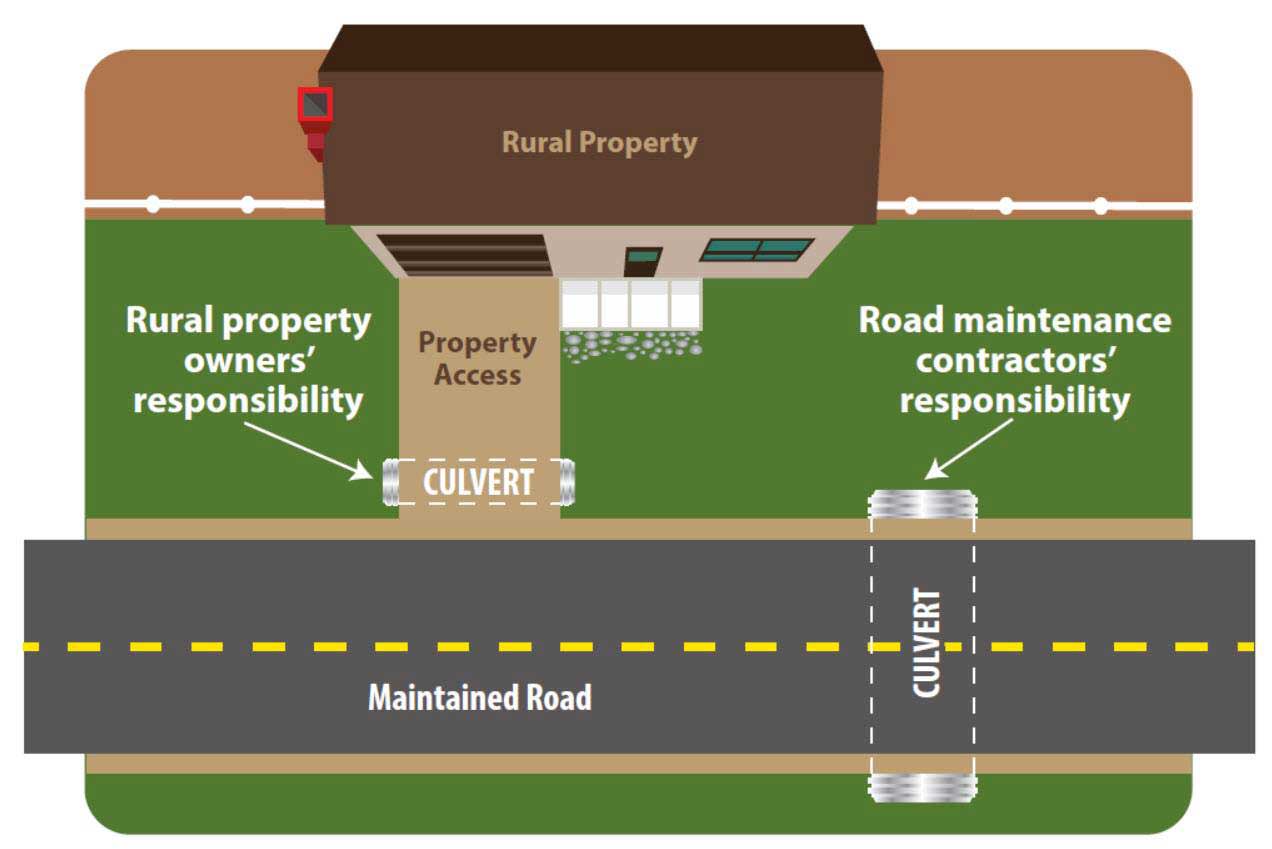
Do you need to make an emergency stop on BC Hwy 17?
Here’s some helpful information (weather permitting of course)
Highway 17 (SFPR) Suggested Emergency Stop Locations – Westbound Direction
W/B #1: Wide shoulder, approximately 400 m west of Port Mann Bridge
W/B #2: Wide shoulder, approximately 1.2 km west of Tannery Road Underpass
W/B #3: Wide shoulder at Elevator Road
W/B #4: Truck stopping area on shoulder, approximately 850 m west of Highway 91 Connector Interchange
Highway 17 (SFPR) Suggested Emergency Stop Locations – Eastbound Direction
E/B #1: Wide shoulder at 36th Ave Overpass
E/B #2: Wide shoulder, approximately 450 m east of Highway 99 off ramp
E/B #3: Wide shoulder, approximately 1.5 km east of Highway 99 Interchange
E/B #4: Truck stopping area on shoulder, approximately 1.8 km west of Highway 91 Connector Interchange
E/B #5: Wide shoulder, approximately 1.5 km west of Tannery Road Underpass
Who ensures the work is being done properly?
Mainroad has a rigorous quality assurance program that tracks our performance. If areas of concern are detected, measures are implemented to address the shortcomings, and processes are modified to prevent recurrence. Mainroad is an ISO-compliant company, and its quality programs are built on those models.
The Ministry of Transportation and Infrastructure conducts ongoing inspections, which include a high-level overview using resources from across the Province, as well as numerous detailed in-field inspections.
Where can I direct concerns about road conditions to Mainroad Fraser Maintenance?
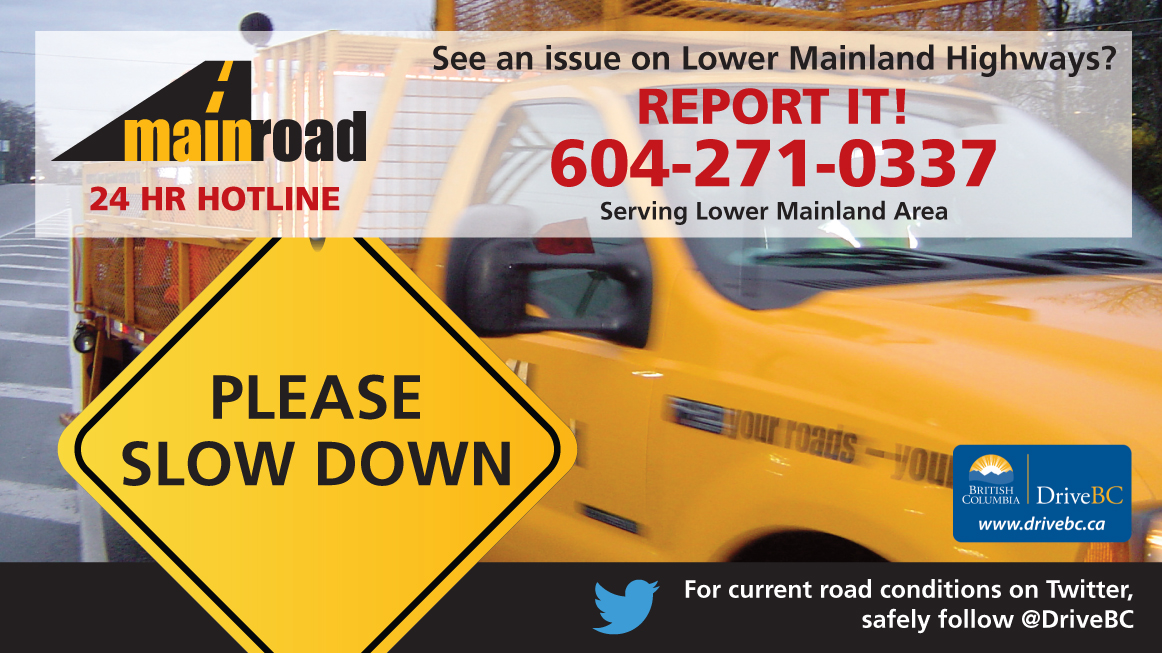
We value public feedback! If you encounter a highway situation on the SFPR that requires maintenance, notice changing road conditions, or see debris, please call 604-271-0337 to report the condition and location.
Mainroad’s Call Centre is available 24/7. An operator will record all public feedback, forward the information to crews on shift, dispatch additional personnel if needed, and update DriveBC.
You can also write Mainroad Email: mfm@mainroad.ca
Where can I find news about Mainroad?
Please visit our recent news page
Here’s what you can do to stay safe during winter driving conditions:
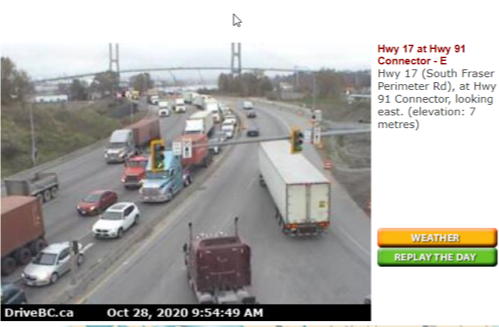 Visit DriveBC | www.drivebc.ca
Visit DriveBC | www.drivebc.ca
- For current road conditions
- For weather forecasts
- For real-time conditions via webcams
Fall and winter weather can be unpredictable and when we tend to experience all types of driving conditions in the Lower Mainland; heavy rain, fog, icy conditions and snow.
Give your vehicle a winter check-up and equip your family with a winter survival kit so you’re not caught off guard when weather conditions deteriorate.
We encourage drivers to choose the best winter tires possible when driving in snow and ice, and to ensure tires are in good condition, with a minimum tread depth of 3.5 mm.
Carry an emergency survival kit with non-perishable food, blankets and first aid supplies, windshield scraper and snow brush, extra windshield washer fluid, fuel line antifreeze, flares and matches or lighter, tire chains and gloves, shovel and traction mat, sand or kitty litter, flashlight and extra batteries, battery jumper cables, spare tire wheel wrench and jack, extra clothing and footwear and sandbags for extra weight.
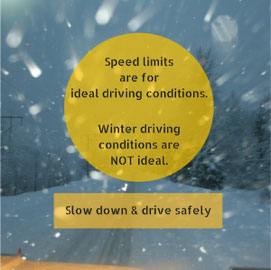 Driving during winter driving conditions
Driving during winter driving conditions
- Conditions change and so should your speed. Please SLOW DOWN and drive for the conditions.
- We encourage all motorists to drive to the conditions during the winter season, slow down, and increase the distance between yourself and the vehicle in front of you.
TranBC Link: How to drive around snow plows in British Columbia
Snow Plow Safety Do’s and Don’ts
Do……Turn on your head and taillights during heavy snow or rain, even during the day.
Do……Use winter-rated snow tires with the mountain-snowflake symbol.
Do……Watch for the flashing amber lights. It can be difficult to see snow removal equipment.
Do……Give snow plows plenty of space – about 10 car lengths. Salt and winter abrasives, as well as rocks and other debris in the snow, can fly – hitting nearby vehicles and decreasing visibility.
Do……Remember the road surface ahead of the plow hasn’t been plowed yet therefore please slow down and be patient. The operator will eventually pull over when it is safe to do so to allow motorists to pass, so take your time, wait and be safe.
Do……Pull as far over to the right as is safe when you see a snow plow approaching from the opposite direction along an undivided highway. That way, you will be clear of any salt or winter abrasives.
Do……Give the snow plow operator a wave when they pull over to let you pass. They’re doing the job for you!
Don’t……Assume the snow plow operator can see you, especially if you’re driving too close and visibility is poor (which it often is in snowstorms). Your best defense is to keep your distance.
Don’t…
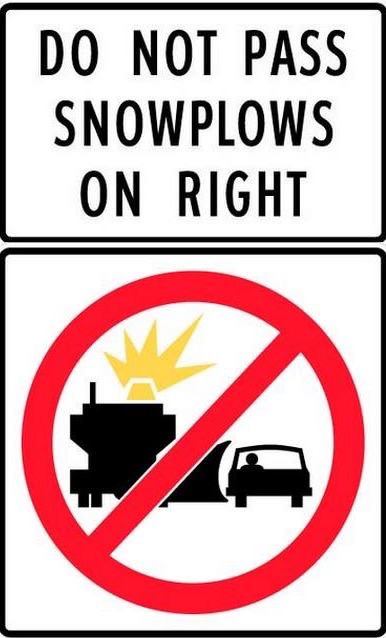 …Pass snow plows. It’s not safe. When drivers attempt to pass a plow truck, they put themselves, their passengers, the snow plow operator and other motorists at risk. The plow could be equipped with a wing blade on its left or right side, which can be obstructed by the snow it’s throwing. The plow also may be the first of a series of two to four more plows, staggered diagonally across the road to clear all lanes simultaneously. This practice is called Echelon Plowing and would require the unwise driver to make multiple unsafe passes.
…Pass snow plows. It’s not safe. When drivers attempt to pass a plow truck, they put themselves, their passengers, the snow plow operator and other motorists at risk. The plow could be equipped with a wing blade on its left or right side, which can be obstructed by the snow it’s throwing. The plow also may be the first of a series of two to four more plows, staggered diagonally across the road to clear all lanes simultaneously. This practice is called Echelon Plowing and would require the unwise driver to make multiple unsafe passes.
Don’t……Tailgate. Tailgating any vehicle puts you at risk of a collision; tailgating a piece of heavy equipment armed with plows only ups the consequences.
Drivers may not be aware…Snow plows must travel slower than regular traffic when pushing snow and spreading salt and winter abrasives.
Snow plows stop at railway crossings to ensure it is safe to cross and that the plow blade will clear the track.
Shift into Winter and TranBC Winter Driving Online Resources
Mainroad is a Winter Driving Safety Alliance partner. We actively promote Shift into Winter, a public awareness campaign designed to inform B.C. drivers about the importance of safe winter driving. We encourage everyone to visit www.shiftintowinter.ca for resources and tips on how to stay safe on the road this winter.
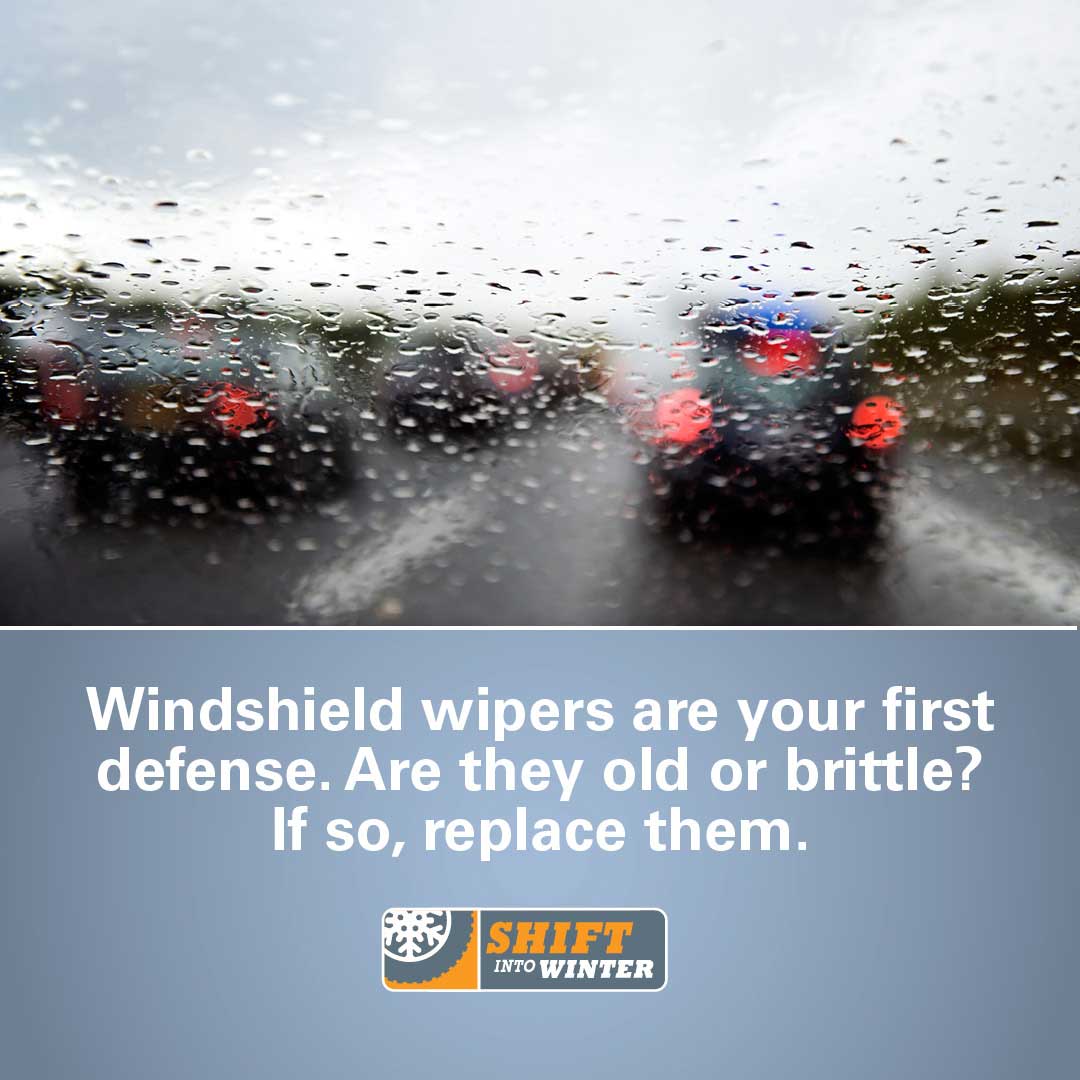
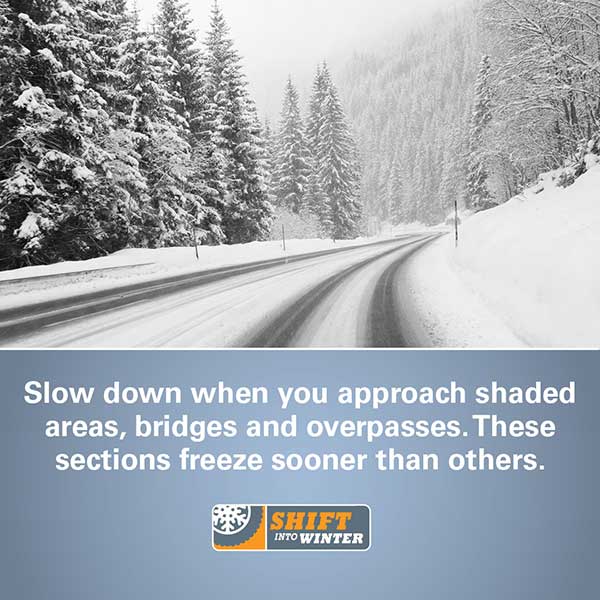

Additional information about B.C. Highway and Bridge Maintenance
Commercial Vehicle – Tire and Chain Requirements
Designated Winter Tire & Chain-up Routes
Enforcement of Winter Tires & Chains Requirement
Motorcycle – Tire and Chain Requirements
Passenger Vehicle – Tire and Chain Requirements
Recreational Vehicle & Trailer – Tire and Chain Requirements
Travelling in an Avalanche Area
Municipal boundary snow removal operations
City of Delta | snow and & ice preparedness
City of Surrey | winter snow and ice control operations

